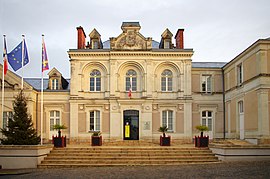Brissac-Quincé
Appearance
Brissac-Quincé | |
|---|---|
Part of Brissac Loire Aubance | |
 Mairie in Brissac-Quincé | |
| Coordinates: 47°21′21″N 0°26′49″W / 47.3558°N 0.447°W | |
| Country | France |
| Region | Pays de la Loire |
| Department | Maine-et-Loire |
| Arrondissement | Angers |
| Canton | Les Ponts-de-Cé |
| Commune | Brissac Loire Aubance |
Area 1 | 9.76 km2 (3.77 sq mi) |
| Population (2017)[1] | 3,095 |
| • Density | 320/km2 (820/sq mi) |
| Time zone | UTC+01:00 (CET) |
| • Summer (DST) | UTC+02:00 (CEST) |
| Postal code | 49320 |
| Elevation | 33–78 m (108–256 ft) (avg. 59 m or 194 ft) |
| 1 French Land Register data, which excludes lakes, ponds, glaciers > 1 km2 (0.386 sq mi or 247 acres) and river estuaries. | |
Brissac-Quincé is a former commune of the Maine-et-Loire département, in France. It was created in 1964 from a regrouping of two former neighbouring communes, Brissac and Quincé. On 15 December 2016, Brissac-Quincé was merged into the new commune of Brissac Loire Aubance.[2]
The French mathematician Charles-René Reynaud (1656–1728) was born in Brissac. The Château de Brissac is located in the commune.
Population
| Year | Pop. | ±% |
|---|---|---|
| 1793 | 1,000 | — |
| 1800 | 697 | −30.3% |
| 1806 | 662 | −5.0% |
| 1821 | 942 | +42.3% |
| 1831 | 932 | −1.1% |
| 1836 | 977 | +4.8% |
| 1841 | 922 | −5.6% |
| 1846 | 972 | +5.4% |
| 1851 | 953 | −2.0% |
| 1856 | 958 | +0.5% |
| 1861 | 988 | +3.1% |
| 1866 | 986 | −0.2% |
| 1872 | 1,002 | +1.6% |
| 1876 | 1,069 | +6.7% |
| 1881 | 1,050 | −1.8% |
| 1886 | 987 | −6.0% |
| 1891 | 949 | −3.9% |
| 1896 | 946 | −0.3% |
| 1901 | 952 | +0.6% |
| 1906 | 992 | +4.2% |
| 1911 | 939 | −5.3% |
| 1921 | 863 | −8.1% |
| 1926 | 883 | +2.3% |
| 1931 | 908 | +2.8% |
| 1936 | 900 | −0.9% |
| 1946 | 904 | +0.4% |
| 1954 | 852 | −5.8% |
| 1962 | 987 | +15.8% |
| 1968 | 1,671 | +69.3% |
| 1975 | 1,668 | −0.2% |
| 1982 | 1,942 | +16.4% |
| 1990 | 2,275 | +17.1% |
| 1999 | 2,294 | +0.8% |
| 2006 | 2,552 | +11.2% |
| 2009 | 2,898 | +13.6% |
| 2010 | 2,931 | +1.1% |
Twin towns
 Caluso, Italy
Caluso, Italy
See also
References
- ^ Téléchargement du fichier d'ensemble des populations légales en 2017, INSEE
- ^ Arrêté préfectoral 6 September 2016 (in French)
Wikimedia Commons has media related to Brissac-Quincé.




